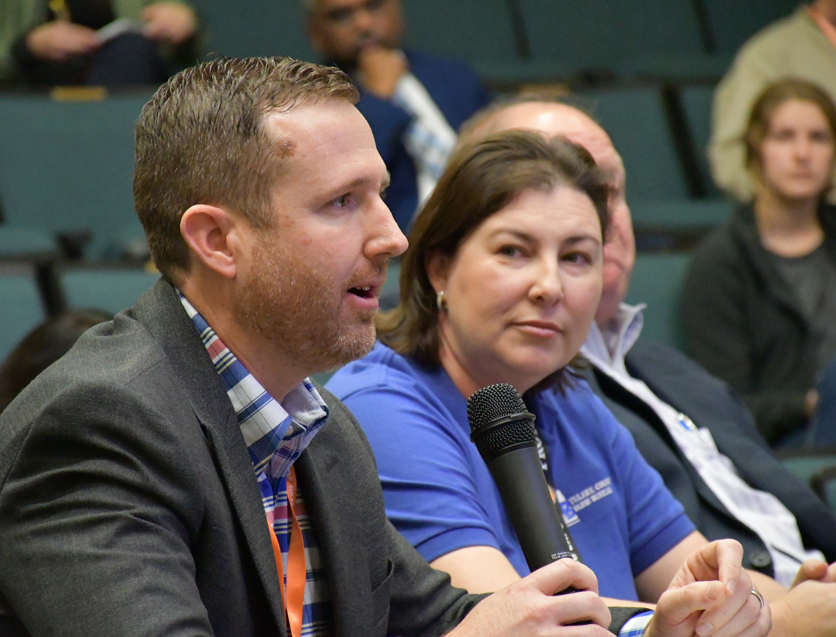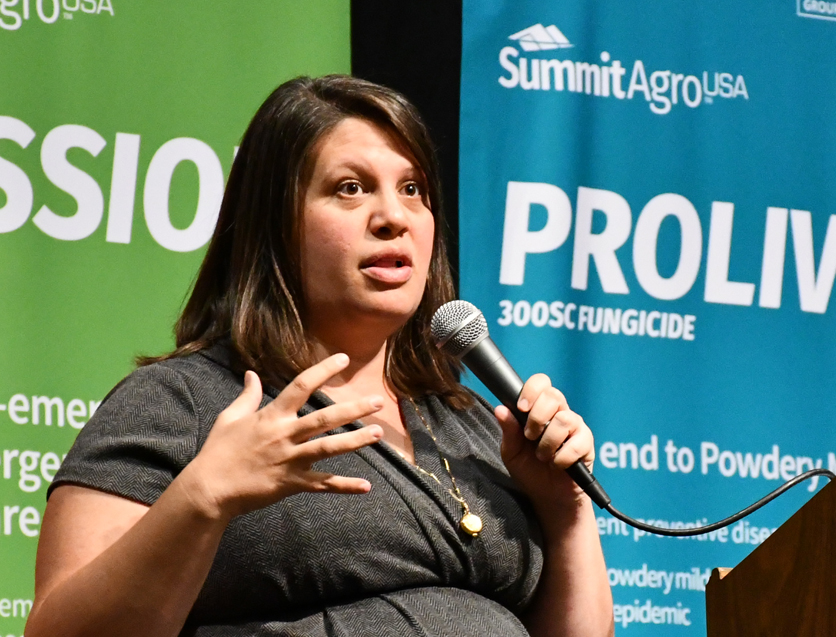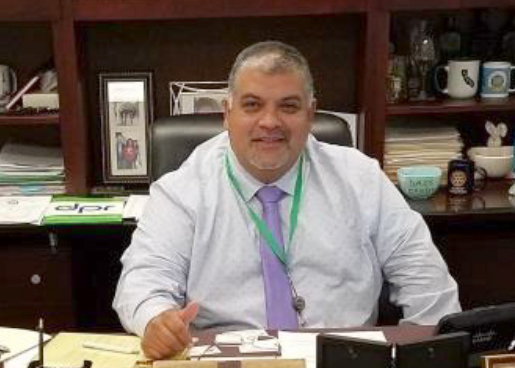The Department of Pesticide Regulation (DPR) has released a list of proposed mitigation measures to limit the use of four controversial and widely used neonicotinoid pesticides in California. Both a CDFA economic analysis and trade groups say the cutbacks could be devastating for citrus, winegrape and cotton growers.
While it is still early in the regulatory process and changes are likely to come for the draft regulation, the proposal renews skepticism over the administration’s agenda in limiting valuable crop protection tools. Farmers have not yet had a full season to begin to understand the impacts from a recent state ban on another critical insecticide, chlorpyrifos.
DPR presented the draft regulation just days after news that citrus greening has been making inroads in commercial groves. Researchers detected the first sample in a commercial grove of an Asian citrus psyllid (ACP) that tested positive for the bacteria that causes the disease, known as huanglongbing (HLB). Neonics have played a critical role in keeping the pest at bay, which means dramatic restrictions on use would have deep impacts for citrus.
“If you add on the neonicotinoids, it's really a death sentence to the California industry,” said Casey Creamer, president and CEO of California Citrus Mutual (CCM), in an interview.
The industry would slowly erode over time, as happened in Florida, he explained.
An economic analysis performed by CDFA and released on Monday found that the regulation would cut the number of acres treated with neonics by nearly 70%. The available alternatives to the products would increase costs for citrus growers by more than 50%, adding up to as much as $3 million for the industry each year. HLB would then “spread at a faster rate in the state, jeopardizing the entire industry,” according to the study. It would also leave growers vulnerable to future invasive species yet to arrive in California.
Cotton would experience a similar fate, according to the analysis, cutting the acres able to be treated with neonics down by about 60% or more. The amount applied would be reduced just as much.
California leads the nation in processed tomatoes. Under the proposed regulation, treatment costs would rise as much as 130%, adding up to an additional $7.8 million each year.
Overall, about 60% of California’s fruit, nut and vegetable production currently depends on the neonics, along with more than half of the state’s agricultural exports. Chlorpyrifos would have been considered an alternative “for multiple crop/pest combinations” covered in the report.
DPR released its risk evaluation for the neonics in 2018, and Citrus Mutual has been working closely with the department’s staff on the potential regulations. Creamer remains optimistic the proposal will evolve over time to address the many issues being raised. CCM’s biggest concern, he said, is that the mitigation measures, particularly for imidacloprid, do not correlate with the 2018 risk evaluation.
“The reaction in the mitigation is to drop the (application) rate down significantly to below efficacy for citrus,” he said. “It basically prohibits the use.”

California Citrus Mutual CEO and President Casey Creamer
Creamer also took issue with an emergency provision in the regulation that would allow for exemptions during ACP outbreaks.
“We're trying to prevent an emergency, not wait till we get one and then be able to use imidacloprid,” he said.
With restrictions limited to just one application per season and at such low rates, many stakeholders raised concerns during workshops last week that the mitigations would build resistance in pests to the neonics as well as to alternatives.
“For all intents and purposes, they cut the rate in half to protect pollinators,” said Ruben Arroyo, the agricultural commissioner for Riverside County, where the ACP detection took place.
The DPR proposal raised a number of questions for Arroyo over enforcement.
“If you've got a grower that can only use it once in a one-and-done type of thing, how would we know if he used it again?” he said.
Arroyo explained that the reporting system for monitoring pesticide use does not have the capability to track the many scenarios DPR seeks to enforce. The regulation still allows for some crops to have multiple applications of a neonic instead of just one. A new software system would be needed for the monthly reports. It would have to trigger alerts, for example, when an applicator might use two different neonics on the same field in one season.
This would require DPR to implement a new funding mechanism, pulling resources from other DPR duties. Another route the department could pursue is to make the four neonic ingredients restricted materials. But that would require a separate regulatory path and present other problems.

CAPCA CEO and President Ruthann Anderson
“I've never been in this situation where we've had a chemical that is in the middle of a reevaluation and mitigation and then switch gears into making it restricted,” said Arroyo.
DPR staff mentioned during the workshops that the agency is also pursuing a human health assessment for imidacloprid. Arroyo said an impact on human health would be enough cause to consider regulating the products as restricted material, with the known risks to pollinators adding further momentum. Yet U.S. EPA has already performed a risk assessment that found the neonics to be safe for human health. CalEPA would have to present new scientific information to counter the federal government’s findings—the path it pursued in banning chlorpyrifos last year.
At that point, banning the neonics or mitigating them out of practice would create other risks.
“The alternative isn't nothing,” said Ruthann Anderson, CEO and president of the California Association of Pesticide Control Advisers. “You're looking at a whole different slew of potential environmental and human impacts.”
As with chlorpyrifos, industry stakeholders, along with environmental advocates and DPR, are reluctant to endorse alternatives that could present unintended consequences, perhaps by requiring more applications or a broad combination of pesticides to achieve the same result.
John Aguirre, president of the California Association of Winegrape Growers, said the neonics are the new and safe replacement for older pesticides like carbamates and organophosphates.

Riverside County Agricultural Commissioner Ruben Arroyo
“This was a new class of chemistry that represented a substantial improvement in terms of risk,” he said. “It's not clear to me how the current evidence is lacking the current studies and analysis to date in terms of human health risk.”
Aguirre was concerned about the regulation’s impacts for controlling vine mealy bug, which is a vector for leaf curl virus. The CDFA report notes the mitigations could also present unforeseen setbacks in combatting the glassy winged sharpshooter in citrus groves near vineyards, since the pest can then spread the devastating Pierce’s disease to wine grapes.
Aguirre pointed out that grapes make a very poor forage crop for pollinators, which the regulations seek to protect.
Anderson hopes DPR will make more informed decisions for protecting pollinators based on data already at hand. This is the first year that the state’s BeeWhere platform is fully operational. The online pesticide notification tool aims to prevent accidental colony exposures during applications. This year beekeepers registered more than 1.5 million honeybee colonies with the program.
“BeeWhere is basically tied into the pesticide use reporting,” Anderson explained. “If there were bee kills or if there were reported issues, then all of that could be investigated and tied together through the two systems.”
This would allow DPR to track colony losses back to a specific pesticide application or to other potential causes, such as pesticides a beekeeper applied to control deadly varroa mites. This would give DPR a more realistic reporting of the actual issues, rather than depending on results performed in a confined lab space, she said.
Since the ban on chlorpyrifos, a number of farmers and other stakeholders have taken issue with how the administration is limiting the tools as well as the opportunity for applicators and pest control advisors to choose the best practice. The administration has said that both the ban and the proposed neonic regulations are part of what DPR Director Val Dolcini describes as sustainable integrated pest management (IPM).
“More broadly, what we're trying to do as a department is to shift the paradigm, in many ways, from our reliance on synthetic chemical pesticides to one that focuses more on safe, sustainable pest management techniques and tools and practices and protocols,” he said during one of the workshops.
Before joining the administration in 2019, Dolcini was CEO of the Pollinator Partnership, a group that has worked with the agriculture industry on bee protection practices, including a high-profile partnership with the Almond Board of California earlier this year. But many are skeptical of Dolcini’s sustainable IPM approach.
Interested in more coverage and insights? Receive a free month of Agri-Pulse West.
“An IPM program doesn't mean you're using organic products or you're not using any products at all,” said Arroyo. “To transition away from IPM to an organic program and not use synthetic materials—until that becomes law, that's like telling me I need to drive an electric car when I want to use a diesel truck. I have that right to choose.”
Aguirre called the sustainable IPM approach biased, saying it broadly discriminates against a category of pest control products and pushes farmers away rather than opening up new opportunities for them.
“That just plays into this canard that if it's synthetic it must be risky, and that nonsynthetic organic products are inherently safer, which is not the case,” he said.
A “more appropriate” approach would be to use the regulatory system to drive innovation in the industry to bring lower-risk products to the marketplace.
Despite these concerns, Creamer remains optimistic, knowing that DPR as a regulatory agency is guided by a scientific process and that Dolcini, who understands the complexity at hand, has pledged to personally work with stakeholders on the issue.
“DPR, to be a credible entity now and in the future, is really going to be based upon science,” he said. “I would be very concerned if they didn't make changes based upon due knowledge or science that’s made available.”


